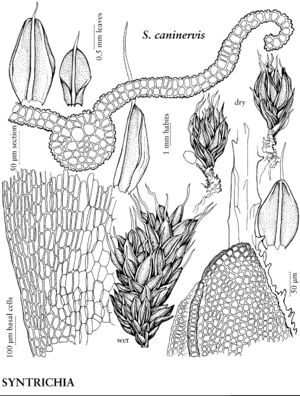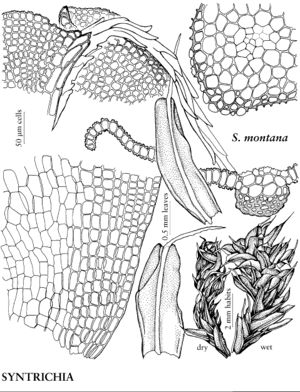Syntrichia
J. Bot. (Schrader) 1801(1): 299. 1801 ,.
| Taxon | Illustrator ⠉ | |
|---|---|---|
 | Syntrichia caninervis | Patricia M. Eckel |
 | Syntrichia latifolia | Patricia M. Eckel |
 | Syntrichia montana | Patricia M. Eckel |
| ... further results | ||
Plants small to large tufts, green to yellow or redbrown. Stems simple or forked, epidermal-cells differentiated in 1–3 layers, central strand usually present. Leaves appressed and variously twisted when dry, erect-spreading to squarrose when moist, obovate, spatulate, or lingulate, rarely broadly oblong-lanceolate; margins plane or revolute, usually entire; apices acute to truncate or emarginate, and often apiculate; costa generally strong, percurrent to long-excurrent as a hyaline or colored awn, usually rounded abaxailly, in section showing 1 median layer of large guide cells, 1–3 layers of smaller adaxial cells, a weak or strong abaxial stereid band, and sometimes a group of hydroids, but no abaxial epidermis of larger cells; basal-cells abruptly differentiated, large and rectangular, smooth, hyaline, thin-walled, often lax; distal cells quadrate or sometimes slightly longer than wide, small and obscure to large and lax, usually pluripapillose on both surfaces, rarely 1-papillose only on the abaxial surface; marginal cells sometimes differentiated, thicker-walled and colored or pale. Specialized asexual reproduction often present, propagula borne on the lamina or costa, in leaf-axils, or on rhizoids, in shape leaflike, spherical, or cylindric. Sexual condition dioicous, autoicous, or synoicous; perigonial bracts often short, ovate or oblong-lingulate, blunt, with costa often ending before the apex, perichaetia terminal, the bracts not differentiated. Seta red or brown, elongate, smooth. Capsule erect, straight or slightly curved, red or brown, cylindric, sometimes with a distinct neck, usually striolate when dry; operculum conic, straight or slightly oblique, shorter than the urn; peristome consisting of 32 filiform, reddish, papillose divisions slightly to strongly twisted together above a pale, tessellated basal membrane 1/6–2/3 the total length of the peristome. Calyptra long-cucullate, acute, yellow or brown. Spores finely to strongly papillose. KOH laminal color reaction brick-red.
Distribution
North America, Mexico, Central America, South America, Europe, Asia, Africa, Atlantic Islands, Pacific Islands (Hawaii), Pacific Islands (New Zealand), Australia, Antarctica
Discussion
Species ca. 80 (17 in the flora).
Syntrichia appears to be a monophyletic group, segregated from Tortula by synapomorphic leaf characters, in particular the large basal cells abruptly differentiated from the small distal cells, usually forming an inverted U-shaped group on each side of the costa. Also, the costal cross section of Syntrichia lacks an abaxial epidermis, unlike the case in Tortula. The high basal membrane of the peristome, while responsible for the name of the genus, is not diagnostic for Syntrichia since an equally high basal membrane has evolved in Tortula as well.
Selected References
Lower Taxa
Key
| 1 | Costa percurrent or short-excurrent into a mucro or apiculus | > 2 |
| 1 | Costa excurrent as an awn | > 7 |
| 2 | Laminal cells collenchymatous (sometimes weakly so; often best observed in the region where the basal and distal cells meet) | > 3 |
| 2 | Laminal cells with evenly thickened walls, not collenchymatous | > 4 |
| 3 | Leaves strongly bordered by thicker-walled, often colored cells; propagula present, cylindric | Syntrichia amphidiacea |
| 3 | Leaves not bordered; propagula absent. | Syntrichia cainii |
| 4 | Propagula present, leaflike, papillose, borne on stalks in leaf axils | > 5 |
| 4 | Propagula absent or, if present, cylindric, smooth, borne on leaf surface | > 6 |
| 5 | Leaves 2-stratose. | Syntrichia chisosa |
| 5 | Leaves 1-stratose. | Syntrichia ammonsiana |
| 6 | Leaves not fragile; propagula present. | Syntrichia latifolia |
| 6 | Leaves fragile, often broken and appearing eroded; propagula absent. | Syntrichia fragilis |
| 7 | Laminal cells collenchymatous, with single papilla on abaxial surfaces. | Syntrichia papillosa |
| 7 | Laminal cells with evenly thickened walls, not collenchymatous, with multiple papillae on both surfaces | > 8 |
| 8 | Leaf margins plane or slightly recurved at mid leaf | > 9 |
| 8 | Leaf margins strongly revolute at least in proximal part of leaf | > 10 |
| 9 | Plants sometimes bearing green, fusiform, axillary propagula; costa smooth abaxially; awn smooth or with a few short teeth. | Syntrichia laevipila |
| 9 | Plants without propagula; costa strongly papillose abaxially; awn serrulate. | Syntrichia bartramii |
| 10 | Leaf 2-stratose or thicker. | Syntrichia caninervis |
| 10 | Leaf 1-stratose | > 11 |
| 11 | Costa lacking hydroids but having a row of large-lumined cells abaxial to guide cells; stem lacking a central strand; basal leaf cells 11-23 µm wide; leaves tapered to the apex from their widest point about one-third the way up from the base, without a constriction near mid leaf | > 12 |
| 11 | Costa with hydroids; stem with a central strand; basal leaf cells 20-40 µm wide; leaves constricted near mid leaf | > 14 |
| 12 | Distal cells with tall, bulging mammillae, 11-14 µm high, as high as the thickness of the lamina, sometimes higher, also bear¡ing 1-2 papillae per cell. | Syntrichia papillosissima |
| 12 | Distal cells with mammillae much lower than thickness of the lamina | > 13 |
| 13 | Leaf margins plane in the distal 1/4; distal cells 13-18 µm. | Syntrichia norvegica |
| 13 | Leaf margins recurved nearly to the apex; distal cells 8-12 µm. | Syntrichia ruralis |
| 14 | Awns short, to 0.5 mm, smooth or with a few short teeth. | Syntrichia sinensis |
| 14 | Awns long, 0.5-3 mm, serrate | > 15 |
| 15 | Distal laminal cells 8-12 µm. | Syntrichia montana |
| 15 | Distal laminal cells 12-23 µm | > 16 |
| 16 | Leaf apex truncate, retuse, or emarginate; costa yellowish to brownish, not serrulate near the apex because of projecting cell ends; distal cells 15-23 µm; autoicous | Syntrichia obtusissima |
| 16 | Leaves acute (or sometimes truncate); costa reddish and serrulate near the apex because of projecting cell ends; distal cells 12-17 µm; synoicous. | Syntrichia princeps |